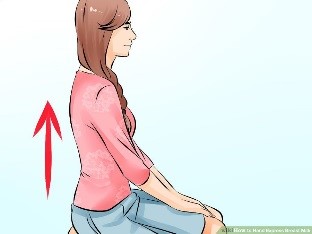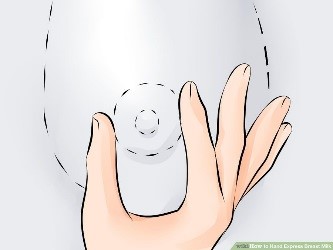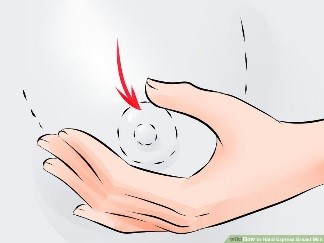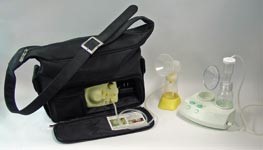Many moms must pump their milk if they wish to feed their child only breast milk for the recommended first 6 months of life. Pumping during the times you would typically breastfeed helps you continue making milk.
Before pumping breast milk, wash your hands with soap and water. Make sure the area where you are pumping and your pump parts and bottles are clean. Breasts and nipples do not need to be washed before pumping.
There are two ways to express breast milk, by hand or pump.
Hand expression is when your hands massage and compress your breasts to remove milk. This technique requires practice. The better you get at it, the easier it becomes and can be as fast as pumping. Hand expression is good for moms who are not away from their babies for very long or very often. BUT, all moms should learn how to hand express because it will always be with you if/when you need it.

Start by sitting up comfortably and leaning forward. This position will make it easier to express your milk, and you will not express as much if you are standing or lying down.

Position your fingers toward the edges of the areola (dark skin around the nipple). Your hand should be in a “C” position.
 Apply pressure inward toward your chest wall. The pressure should be gentle and firm but not feel like you are squeezing your breast. Avoid tightening or stretching your skin over the areola because this will make it more difficult to express the milk. Press your thumb and index finger directly back into the breast tissues. As the saying goes, “press, compress, and then relax.”
Apply pressure inward toward your chest wall. The pressure should be gentle and firm but not feel like you are squeezing your breast. Avoid tightening or stretching your skin over the areola because this will make it more difficult to express the milk. Press your thumb and index finger directly back into the breast tissues. As the saying goes, “press, compress, and then relax.”
Some other things to keep in mind when hand expressing your milk:
- Remember to press back, not out, and roll your fingers, not slide them.
- Roll your thumb and fingers forward so that you squeeze the milk out.
- Keep your fingers together. Spreading your fingers out reduces the effectiveness of the process.
- Lift larger breasts before applying pressure.

Collect the expressed breast milk in a container. If you are expressing just to make your breasts feel more comfortable, you can express the milk into a towel or just express it over a sink. If you would like to save the milk for later use:
- Utilize milk bags to collect the expressed milk.
- Express the milk directly into a bottle for later use.
- Use a funnel to direct the breast milk into a container.
- Use a container with a wider mouth, such as a coffee cup or small jar. Once all the milk has been emptied from the breast, transfer the milk into a storage container.
A manual pump is a hand-held device that uses your hand and wrist to pump milk. Like hand expression, using a manual pump takes practice. A manual pump is useful if you do not have easy access to electricity (wall plug) or for moms who do not frequently pump. To use a manual breast pump, follow these steps.
- Read the instruction manual and learn about the pump.
- Wash your hands and make sure all parts of the breast pump are there and clean.
- Find a place where you feel comfortable and relaxed. Think about your baby; this will trigger the hormones that help release your milk.
- Place the assembled breast shield on your breast, making sure it is centered over your nipple.
- Begin pumping. It may take a couple of minutes for the milk to begin flowing.
- Once the milk begins coming out, adjust how fast you pump, making it inconsistent. This is similar to a baby’s sucking motions.
- Switch breasts about every 5 minutes. Make sure that each breast gets about 15 minutes of pumping. Most women find that one breast produces more milk than the other, which is completely normal.
- When you have finished, remove the breast shield, unscrew the bottle and place a cap on it. Wash any parts that have touched the breast or milk in warm, soapy water. Set the pieces out to air dry.
 The electric breast pump can be easier for some moms. It can pump both breasts at the same time, which is helpful when you return to work or school.
The electric breast pump can be easier for some moms. It can pump both breasts at the same time, which is helpful when you return to work or school.
Using an electric breast pump is very similar to using a manual pump. To use an electric breast pump, follow these steps;
- Make sure you read the instructions and understand how to use your breast pump correctly.
- Make sure the breast shields are the correct size and are centered over the nipple. If the placement is off, the suction can be damaging.
- Think about your baby; this will trigger the hormones that help release your milk.
- Once the milk is flowing, adjust the speed and suction of your pump so that it is inconsistent, similar to the sucking motions of your baby.
- Always keep the parts of your pump clean. Wash with warm, soapy water and air dry after each use. Using a dirty pump may lead to a breast infection.
Storage of breast milk
You can store pumped breast milk in a clean glass or hard BPA-free plastic bottles with tight-fitting lids. You can also use milk storage bags, which are made for freezing human milk. Do not use disposable bottle liners or other plastic bags to store breast milk.
After each pumping (expression)
Label the date on the storage container. Include your child’s name if you give the milk to a childcare provider.
Gently swirl the container to mix the cream part of the milk that may rise to the top. Do not shake the milk. This can cause some of the milk’s valuable parts to break down.
Refrigerate or chill milk right after it is expressed. You can put it in a fridge, place it in an insulated cooler pack, or freeze it in a small (2-4 oz) batches for later feedings.
To freeze your milk
Wait to tighten bottle caps or lips until the milk is completely frozen.
Leave an inch or so from the top of the container because the milk will expand when freezing.
Store milk in the back of the freezer, not on the shelf of the freezer door.
To thaw and warm-up milk
Clearly label milk containers with the date the milk was expressed. Use the oldest stored milk first.
Breast milk does not need to be warmed. Some moms prefer to take the chill off and serve at room temperature. Some moms serve it cold.
Thaw the bottle or bag of milk by putting it in the fridge overnight, holding it under warm running water, or setting it in a container of warm water.
Never put frozen breast milk in the microwave. Microwaving creates hot spots that could burn your baby and damage the milk.
Swirl the milk, don’t shake it. Test the temperature by dropping some on your wrist. The milk should be warm, not hot.
Use thawed breast milk within 24 hours. Do not refreeze thawed breast milk.
